Creating a Gantt Object
This topic describes how to add a new Gantt Object to a Screen or a Container and its specific properties.
To create a new Gantt chart, you need to access a Screen in Design mode.
Once you're in the Screen editing page, locate the Gantt Object from the Screen Objects list in the left panel, then drag and drop it onto your Screen or Container.
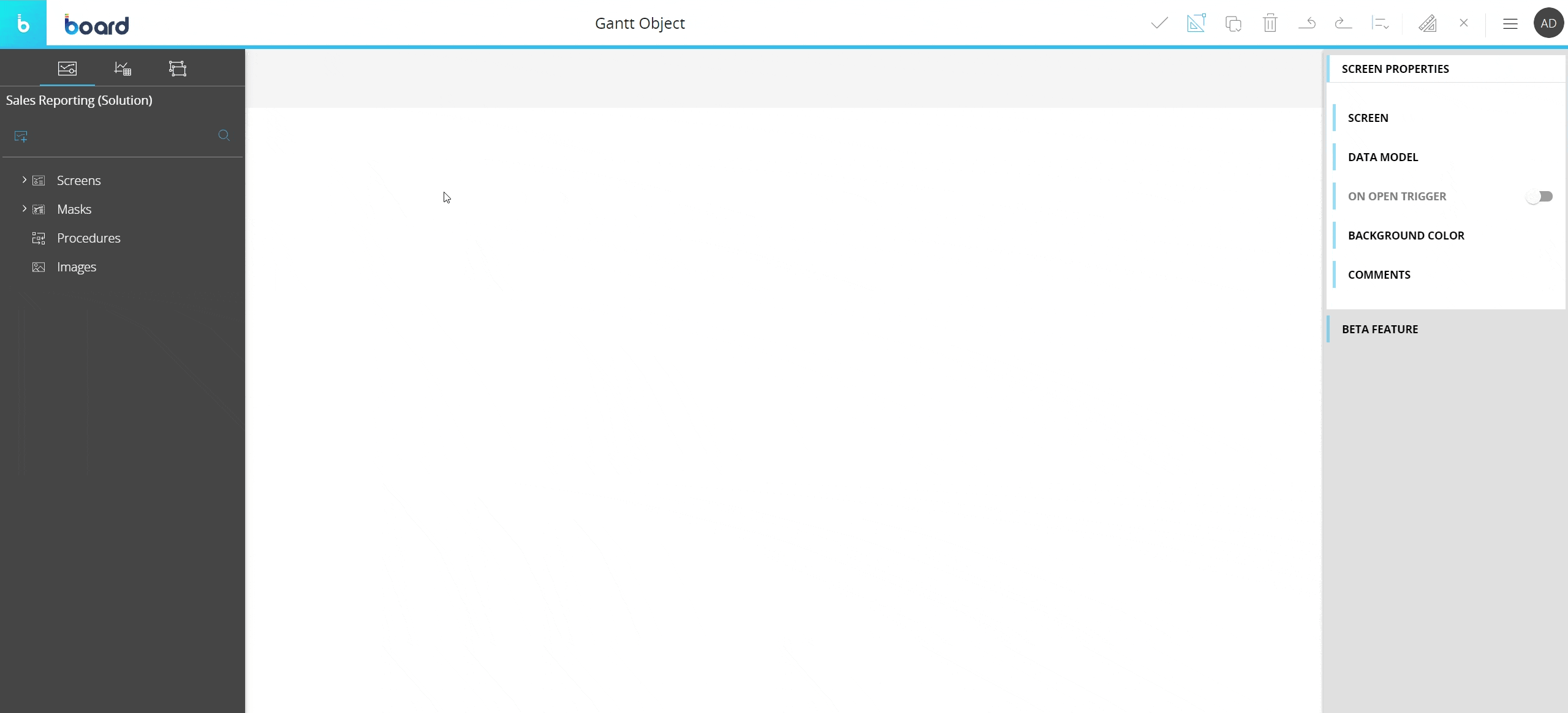
When you create a Gantt chart, it is initially empty. The next step is to configure a Layout that will define the data to be displayed. To do so, click the "Configure me" button or select the Chart Object and click the "Configure layout" button (![]() ) located in the Top Menu of the Capsules workspace.
) located in the Top Menu of the Capsules workspace.
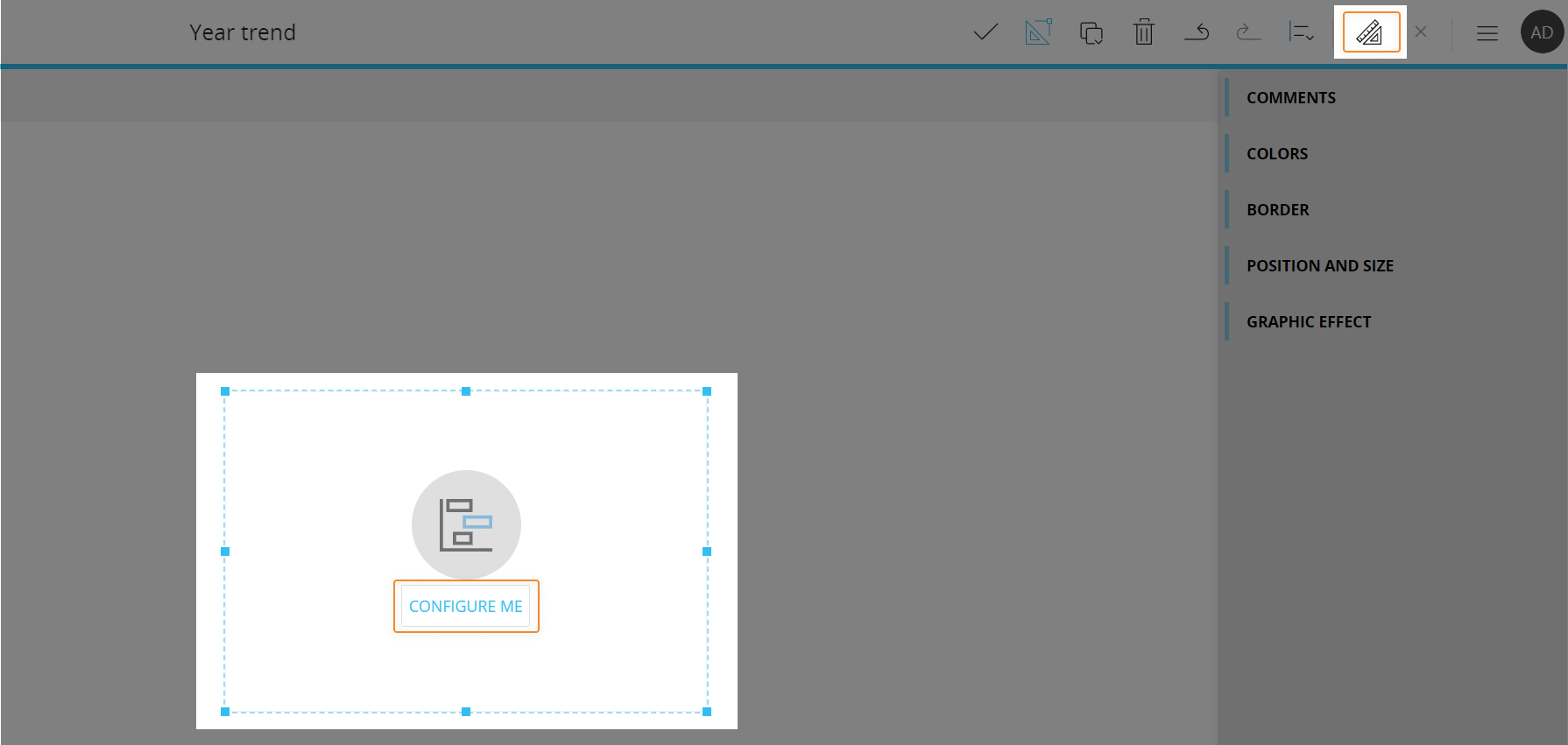
See The Layout Object, Configure a Layout and About data blocks of a Layout for more details on the Layout Object.
The Gantt chart, just like every other Object, can be moved, resized, duplicated via copy/paste and easily aligned with other Objects on the Screen.
See Configure Screen Objects for more details.
Gantt Layout
The Layout editor for the Gantt Object is slightly different from the classic one, in that it offers some specific options and properties.
The main differences are highlighted in the image below:
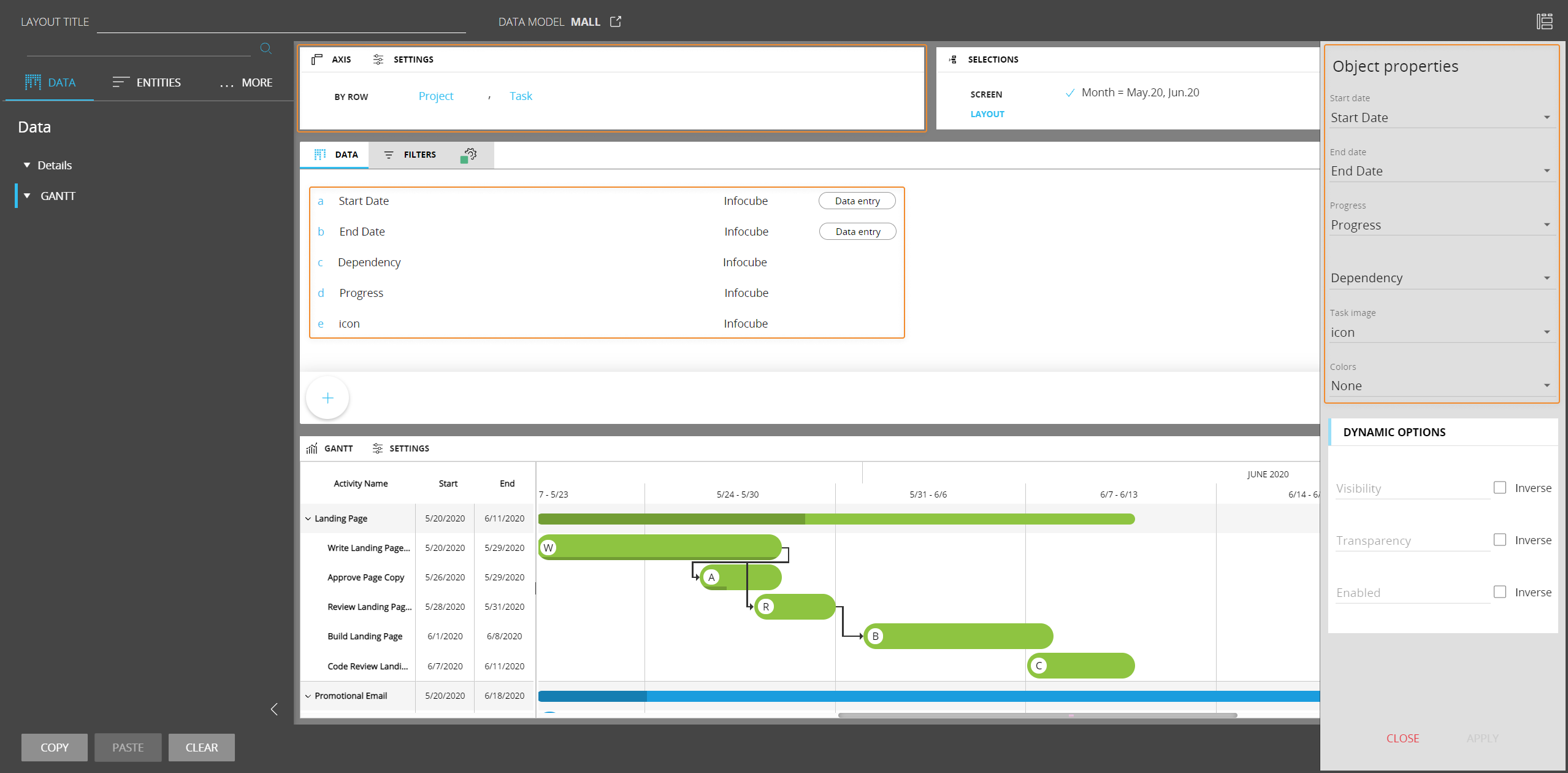
The Axis area
In the Axis area you can define up to two Entities By Row. Those Entities should be part of the same hierarchy and their members should be the project stages and single activities/tasks respectively.
At least one Entity By Row is required.
The Gantt chart doesn't support Entities By Column.
If you add two or more related (i.e. they are part of the same hierarchy) Entities by row, Board will automatically group them: the most nested Entity in a Relationship is always arranged in the rightmost position and you won't be able to rearrange their order. The least nested Entity represents the groups of activities, while the most nested Entity represents single activities.
The Data Area
To build a Gantt chart, you must add the following Block to the Layout:
- A Date type Cube containing the start dates of activities
- A Date type Cube containing the end dates of activities
Both Cubes must be dimensioned by the Entity added by row or, in case two Entities are present, by the most nested Entity added by row.
You can also add additional Blocks to display more information in the chart, such as:
- A Data type Cube containing values that represent the progress of each activity expressed in days
- A Data/Text type Cube containing values that represent the dependencies of project activities
- A BLOB type Cube containing pictures to be displayed at the beginning of each activity bar in the chart
The Cubes mentioned above must be dimensioned by the Entity added by row or, in case two Entities are present, by the most nested Entity added by row.
Example
In the following Layout, all Blocks containing various data to be visualized in the chart have the Entity "Task" in their structure:

The following Data View shows all values/data from those Blocks for each member of the Entity "Task".
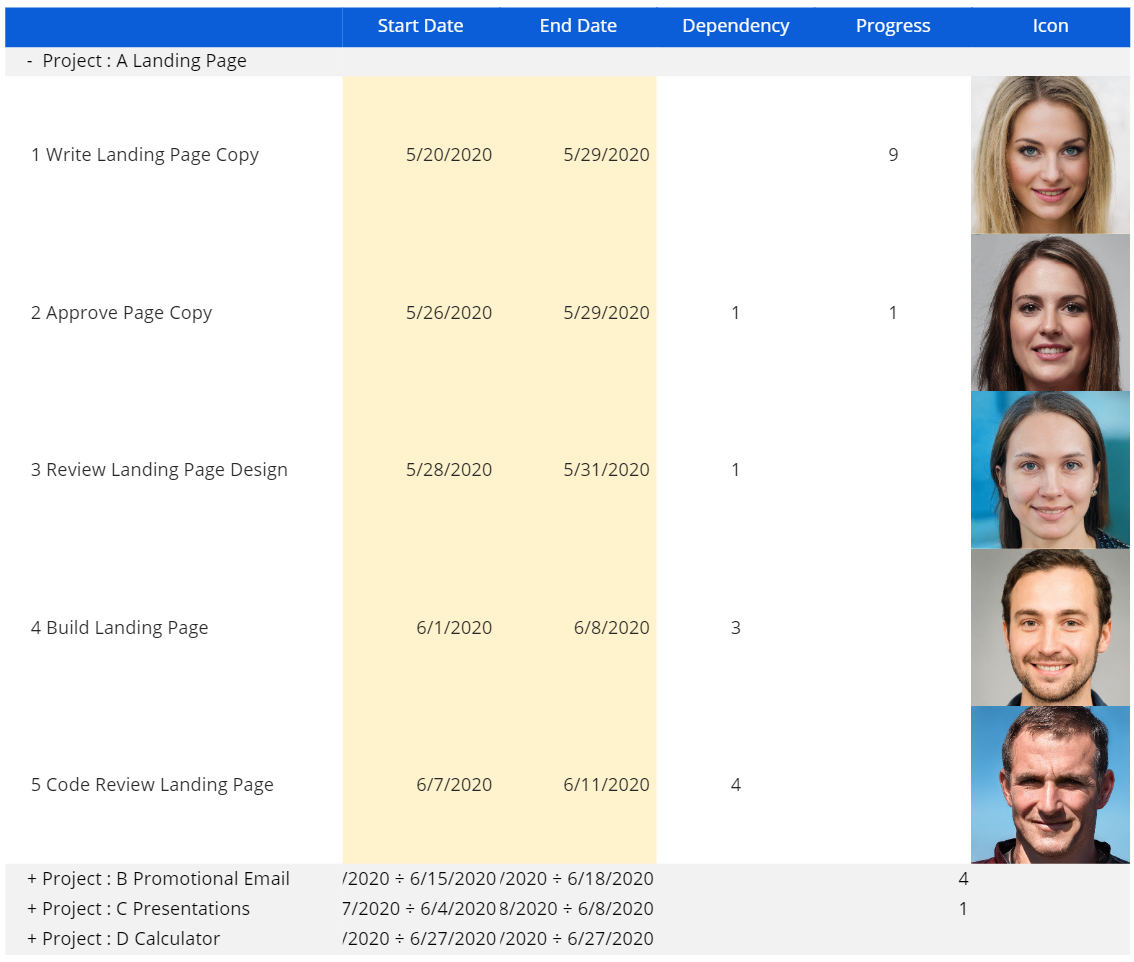
In the case where you configure a Layout with additional Data Blocks, which are displayed in the columns in the left area of the chart, three additional options explained in this page will appear in the Sliding Panel in Play mode. See this page for more details.
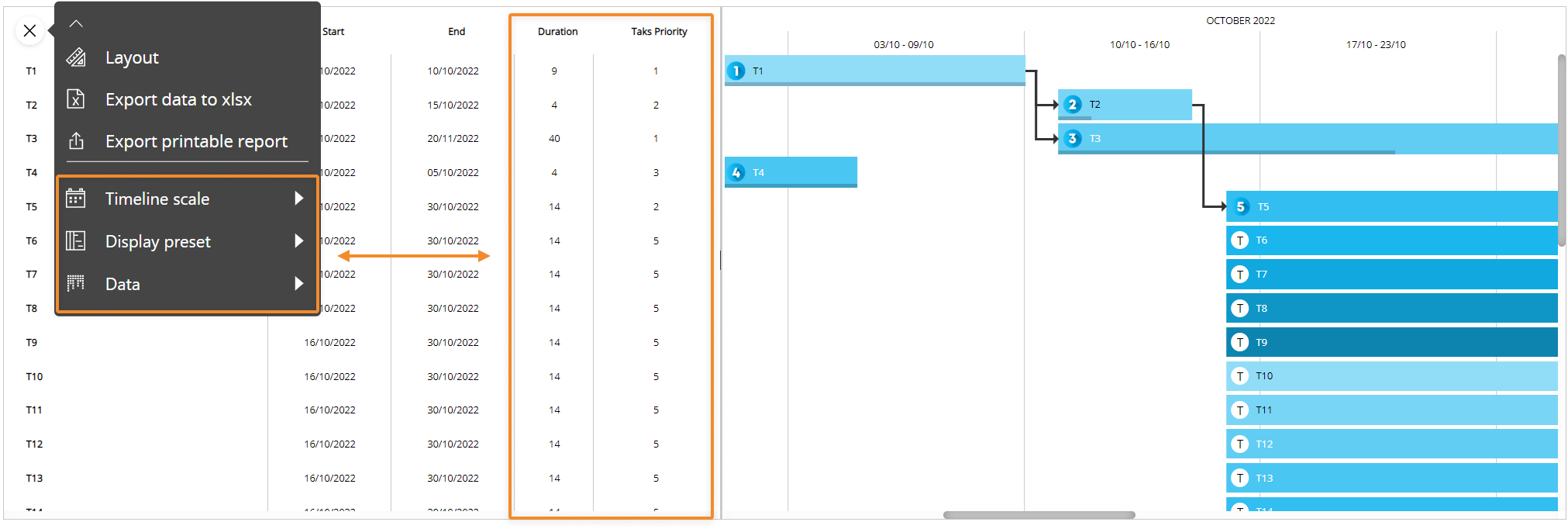
To complete the Gantt Layout configuration, all Gantt charts elements from the Object properties panel must be associated with the correct Blocks. See next paragraph for more details.
Object properties
In the Layout editor, under the Object properties panel, a few dropdown menus allow you to define which Blocks will be used for displaying data in the Gantt chart.
They are the following:
- Start date (required). Defines the Date Cube containing the start dates of activities
- End date (required). Defines the Date Cube containing the end dates of activities
- Progress (optional). Defines the Cube containing values that represent the progress of each activity. If no Block is selected, no progress bar will be displayed on activity bars
- Dependencies (optional). Defines the Cube containing values that represent the dependencies of project activities. If no Block is selected, no arrow showing dependencies will appear in the chart
- Task image (optional). Defines the BLOB Cube containing pictures to be displayed at the beginning of each activity bar in the chart. If no Block is selected, the first letter of each task will be displayed instead
- Colors (optional). Define a Block that will be used as a driver for the color of all activity bars in the chart. If no Block is selected, the palette configured in the contextual right panel of the Screen editing page will be used
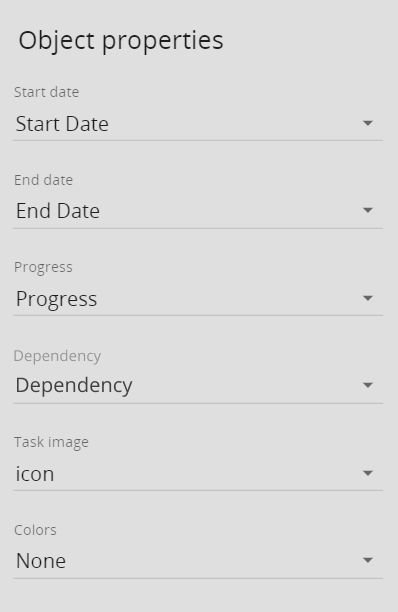
Gantt properties and settings
Gantt properties are available from the contextual right panel of the Screen editing page once the Object is selected and it's associated with a Layout.
The Gantt chart Object supports all options common to all Screen Objects and the following two properties:
- Master object. If enabled, clicking on an activity will update the data displayed by all other Objects on the Screen in order to show only the data relating to that specific activity. The Master object result is similar to applying a Screen Selection
- Disable Drill down. Disables the drill-down functionality, both in Design and Play mode.
Gantt-specific properties are highlighted in the following image and explained below:
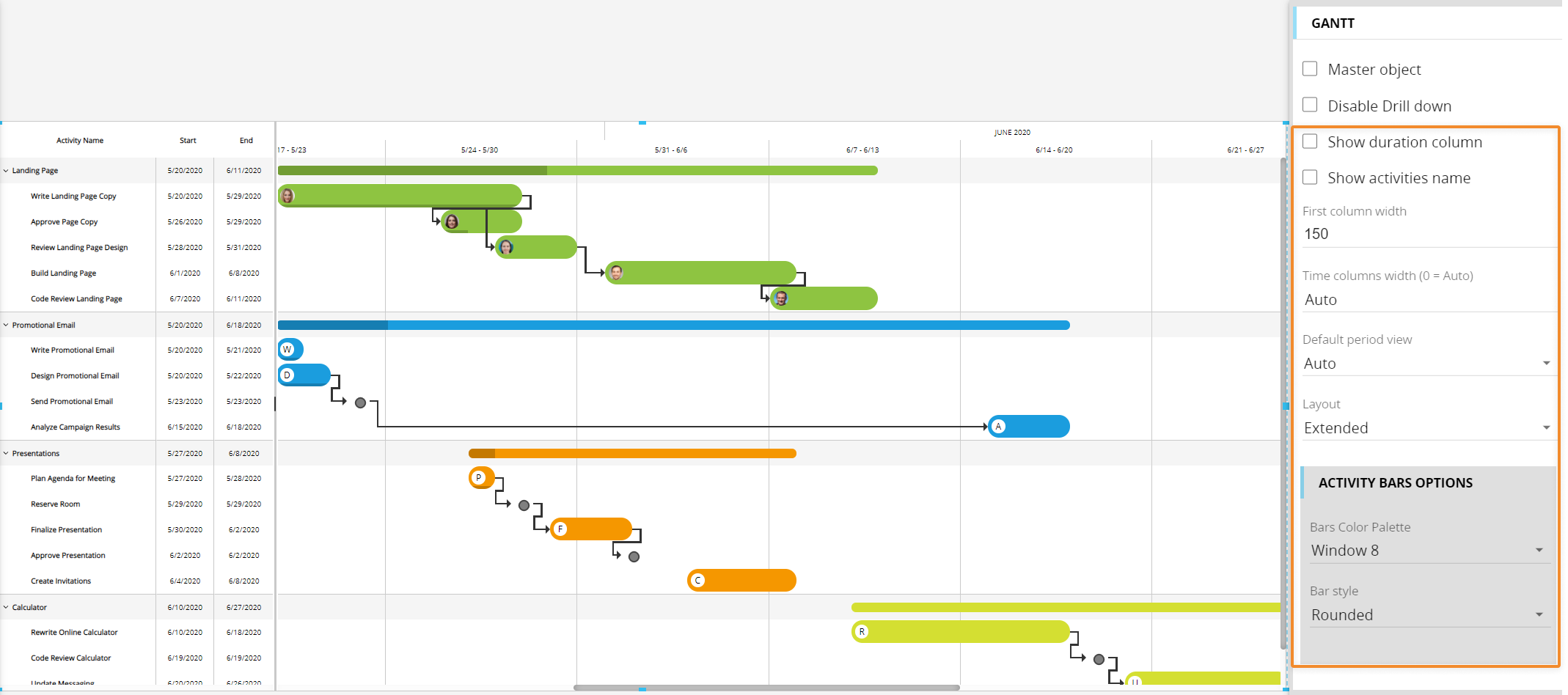
- Show duration column. Shows/hides the "Duration" column in the left area of the chart. Since this option adds a Column, three additional options will appear in the Sliding Panel in Play mode. See this page for more details
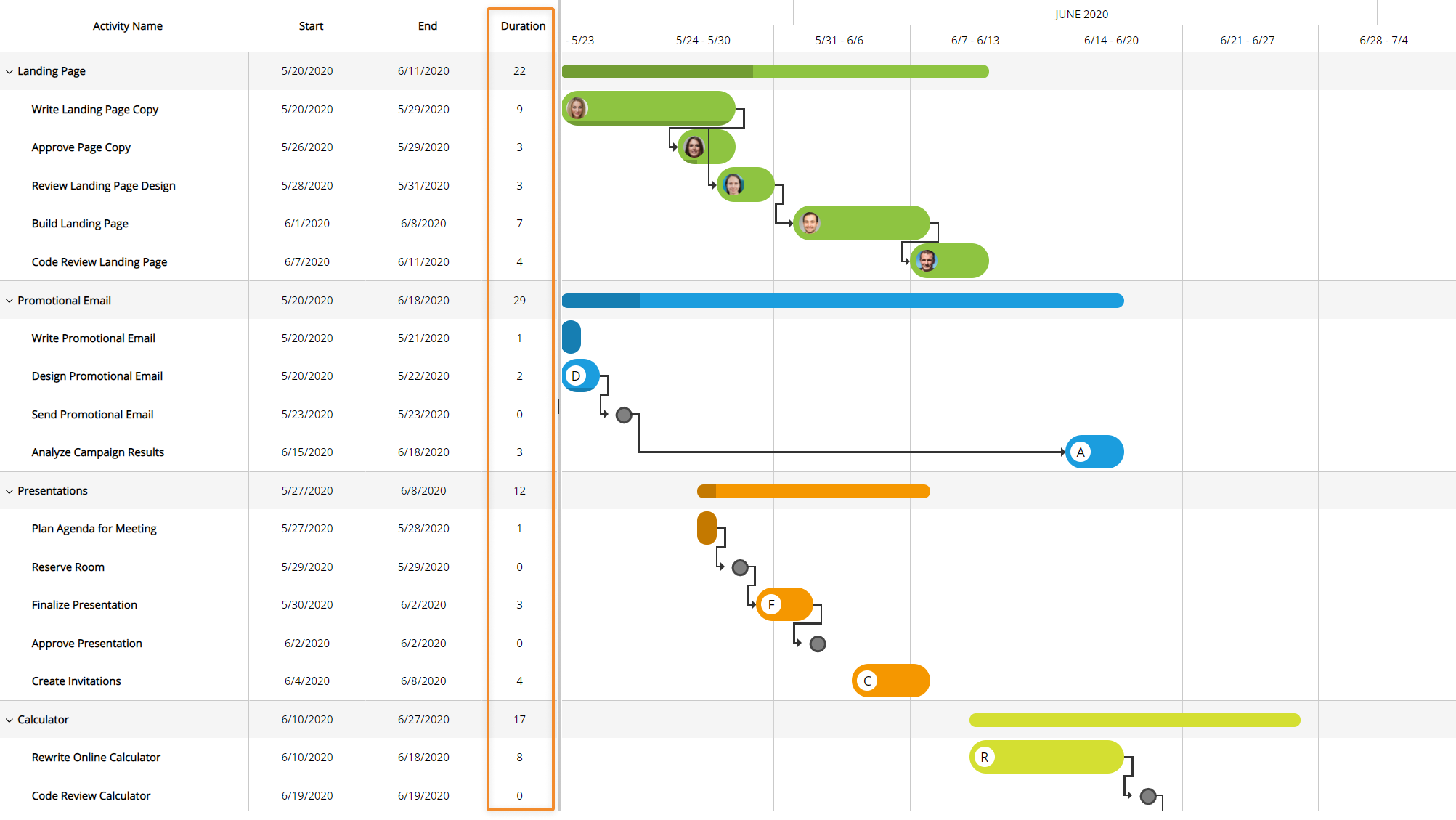
- Show activities name. Shows/hides the activities name within activity bars
- First column width. Defines the width of the "Activity name" column
- Time columns width. Defines the width of time scale columns. Set "0" to have Board automatically select the best setting for this option
- Default period view. Defines the time period used to group time scale columns. Set "Auto" to have Board automatically select the best setting for this option
- Layout. Allows you to define the height of activity bars, compact or extended.
Under the "Activity bars options" menu you can define a default color palette that will be used if no Block has been configured in the Object properties panel of the Layout. You can also define a style for the corners of bars, rounded or square.
Interacting with the Gantt Object in Design mode
In Design mode, the Gantt Object provides the same interactive features available in Play mode, with a few notable differences regarding Drill functions.
You can also configure which options will be available in the contextual menu (sliding toolbar) in Play mode. To do so, hover over the Gantt chart and click the contextual menu icon (![]() ) in the top left corner, then expand it by clicking on the downward facing arrow: the configuration panel is accessible from the gear icon in the top right corner.
) in the top left corner, then expand it by clicking on the downward facing arrow: the configuration panel is accessible from the gear icon in the top right corner.
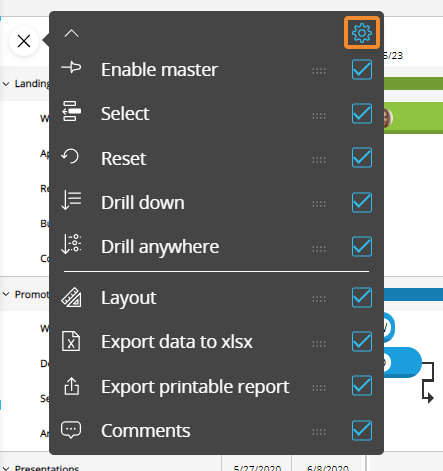
Default drill-down
You can configure a drill down path that will be saved in the chart configuration: that will be the default drill that will be performed in Play mode, when end users click on the Drill down button.
To configure the default drill, proceed as follows:
- Double-click on an activity (row) or select it and click the Drill anywhere icon (
 )
) - From the pop up window, select the Entity to drill down on and click OK. The configured drill is performed and data is displayed in a Data View
- Close the drill down window and save the Screen. The configured drill is now the default drill, both in Design and Play mode
End users will still be able to configure other drill down paths in Play mode, if they're allowed to do so. See next paragraph for more details.
Screen selections and selections made by the user using Selector Objects (if any) also apply to data in drill down windows.
Limit Drill down entities
You can limit drill down paths that end users are allowed to configure by selecting the Entities the user can drill down on.
To do so, while in Design mode, check the "Limit drill down entities" checkbox in the drill anywhere configuration window and select the Entities you want to show to the end user. These entities will be the only ones available during the drill anywhere configuration in Play mode.
Drill-to-screen
To allow users to drill-down from the Gantt chart to another Screen within the same Capsule with a selection on the selected chart element, proceed as follows:
- Double-click on an activity (row) or select it and click the Drill anywhere icon (
 )
) - From the pop up window, select the Screen tab and choose the destination Screen. Check the "Same tab" checkbox to open the destination Screen in the same browser tab.
The Drill to screen mode, if enabled, will open the destination Screen with a selection on the chart element selected or double-clicked by the user in the chart.
The Go to screen mode, if enabled, will open the destination Screen when the user double-clicks on an activity (row) or selects it and clicks on the Drill-down icon. The destination Screen won't inherit any selection from the chart. - Click OK to save the Drill-to-screen configuration.
This feature allows you to nest your analysis in a more powerful way than the standard drill-down, which only changes the level of granularity of a report. In a drill-to-screen navigation the data represented (values, indexes) and types of objects (Charts, Dashboards, Data Views) may vary as the user drills from a top level view to another screen at a more detailed level.
Screen selections and selections made by the user using Selector Objects (if any) also apply to data in in the target Screen.
Drill-procedure
It is possible to trigger a procedure from the chart, when the user double-clicks on an activity (row) or selects it and clicks on the Drill-down icon. The procedure is launched with a selection filter applied based on the clicked chart element.
If a drill-procedure containing two or more procedures is configured, when the user double-clicks on a chart element, a pop-up window allows the user to select the procedure to run from a configured list.
To configure a drill-procedure, proceed as follows:
- Double-click on an activity (row) or select it and click the Drill anywhere icon (
 )
) - From the pop up window, select the Procedure tab and choose the desired Procedures.
- If the checkbox in the middle is unchecked, the dropdown menu on the left allows to choose from procedures saved at the Capsule level
- If the checkbox in the middle is checked, select a Data model from the dropdown menu on the right. By doing so, only procedures belonging to the chosen Data model will be shown in the dropdown menu.
After you've chosen the desired procedure, click the ADD button on the right. Repeat the process for each procedure you want to add to the drill
- Click OK to save the Drill-procedure configuration.
Screen selections and selections made by the user using Selector Objects (if any) also apply to data in drill down windows.
Drill through
It is possible to execute a Drill through from the Gantt chart, when the user double-clicks on an activity (row) or selects it and clicks on the Drill-down icon. The Drill through is executed with a selection filter applied based on the clicked chart element.
Drill throughs are configured in the Drill through section of the Data model.
To configure a Drill through on a chart element, proceed as follows:
- Double-click on an activity (row) or select it and click the Drill anywhere icon (
 )
) - From the pop up window, select the Drill through tab and choose the desired Drill through
- Click OK to save the Drill through configuration.
Screen selections and selections made by the user using Selector Objects (if any) also apply to data in drill down windows.
Learn more about: